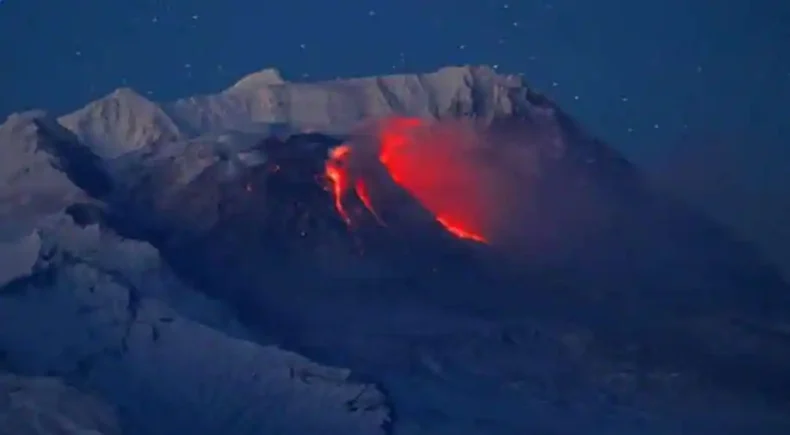Scientists caution, the Shiveluch Volcano- the largest and most active Volcano has increased its activity and may erupt soon- Russia

Picture Credit: NASA Earth Observatory
According to the Kamchatka Volcanic Eruption Response Team, the Schiveluch, an ancient active volcano has become intensely dangerous showing an upsurge in its activities and is increasing violently which may result in creating a violent eruption.
Alexei Ozerov, the head of the Russian Academy of Sciences Far East Branch Institute of Volcanology and Seismology was cited, as saying that “the volcano’s dome is extremely hot”.
Schiveluch Volcano
Schiveluch is the most active volcano in Kamchatka and one of the largest volcanoes in the Peninsula located on the Kamchatka Peninsula in northeastern Russia. It had more major eruptions than any other volcano of our ecological time. Shiveluch and Karymsky are Kamchatka’s largest, most active and most continuously erupting volcanoes. In 1854 and 1957, catastrophic eruptions occurred when a large part of the lava dome collapsed, creating a devastating debris avalanche.
ALSO READ: Iran’s Anti-Hijab Protest
2007 Shiveluch Volcano Eruption
The most violently explosive and recent eruption of the Schiveluch Volcano on the Russian Federation’s Kamchatka Peninsula occurred on March 29, 2007, which left an ash cloud above roughly 9,750 meters.
It was initiated in December 2006 when Shiveluch experienced heightened seismic and volcanic activity. The response team ‘Kamchatkan Volcanic Eruption Response Team (KVERT)’ increased the hazard status when they felt the chances of extreme violent eruptions after explosive activity between 26 to 27 December 2006.
The earthquake was felt daily from 29 December to 12 January 2007. The seismic network recorded approximately 200 shallow earthquakes accompanied by Fumarolic activity, avalanches, and gas and ash flumes that also affected nature drastically rising from 4.3 Km to 13.7 Km altitude.
The number of earthquakes continued, decreasing to 120 per day before increasing again to 200 earthquakes between 2 February to 9 February. The level of plumes increased significantly drifting in various directions. The eruption that emerged on 6 February was not visible on satellite imagery.

March 29, 2007
Astronauts noted the plume aboard the Space Shuttle around 21 March. On 29 March, an ash plume was produced following an explosive event at Shiveluch that, according to the Tokyo VAAC, reached an altitude of 11.9 km. The next day, a cataclysmic event that lasted about 6 minutes produced a plume that reached altitudes of 10.1-12.2 km.
In an ensuing report, KVERT showed that seismic activity continued above background levels during 4-12 April. Based on seismic interpretation, observation, and video data, ash-and-steam plumes rose to altitudes of 4.5-7 km throughout this period. The sizeable thermal inconsistency was visible on satellite imagery during 1-10 April. As of 10 April, the Color Code at Shiveluch remained at Orange.
ALSO READ: 2 Volcanoes Rumble Into Action In Russia’s Far East
Shveluch is a stratovolcano—a steep-sloped volcano composed of alternating layers of solidified ash, hardened lava, and volcanic rocks. One of Kamchatka’s largest volcanoes, it sports a summit reaching 3,283 meters (10,771 feet). Shiveluch is also one of the peninsula’s most active volcanoes, with approximately 60 substantial eruptions in the past 10,000 years.
The eruption of the Shiveluch volcano which is now in danger of erupting anytime soon can cause ash explosions up to 10-15 km. The observatory said on its website that, “as the growth of the lava dome continues, strong fumaroles activity, an incandescence of the lava dome, explosions and hot avalanches accompanies this process”.The Institute of Volcanology said that it had recorded up to 10 explosions per hour and that lava and mud flows were expected.













